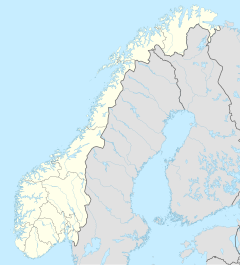Lierne National Park
| Lierne National Park | ||
|---|---|---|
| The national parks in southern Norway (the Lierne is number 16) | ||
|
|
||
| Location: | Trøndelag , Norway | |
| Next city: | Nordli | |
| Surface: | 333 km² | |
| Founding: | 2004 | |
The Lierne National Park ( Norwegian Lierne nasjonalpark , South Sami Lijre ) is a 333 km² Norwegian national park on the border with Sweden . The park is located in Trøndelag Province and belongs to the municipality of Lierne . To the west of the Lierne National Park, also in the municipality of Lierne, is the Blåfjella-Skjækerfjella National Park . Both parks opened on December 17, 2004.
The park was founded to protect the mountain range in the park with its special flora and fauna. Together with the nature reserves, such as the Hotagsfjellene , on the Swedish side, the Lierne forms a large forest and mountain area that has so far been largely spared from human interference. The mountains in the center of the park in particular have characteristic alpine fauna.
Geography, landscape and geology
The park is located north of Sørlivassdraget and to the east on the Swedish border and the rivers Hestkjølen and Muru . The Lierne is also on the watershed between the Baltic Sea and the European Arctic Ocean . In general, the area is relatively flat.
The landscape is characterized by moraine and loess landscapes , such as osen , which were created around 10,000 years ago during and after the last ice age. The highest mountains are the Hestkjøltoppen with 1390 moh and the Merrafjellet with 1266 moh Both mountains are in the Hestkjølplatået high plateau .
Flora and fauna
Due to the rocky subsoil and the cold alpine climate, the vegetation in the park is extremely sparse. Nevertheless, there are some crooked birch forests , wetlands and moors in the park , all of which have rather sparse vegetation.
The largest mammals in the park are arctic fox , lynx , wolverine , and bear . The bird world is dominated by waterfowl such as stilt walkers , ducks , Odin's chickens , dunlins , ringed plovers , falcon skuas , but also golden eagles . The lakes in the park are characterized by abundant fish stocks (especially trout ), which makes them a popular fishing spot.
heritage Site
Relics of early Norwegian settlement from the Bronze Age were found in the park , such as various hunting utensils and even a racing furnace from the 6th century. In addition, traces of Sámi settlement were found, such as the remains of houses, meeting places, graves and holy places.
Tourism and administration
The park is less suitable for relaxed hiking and vacations, as there are hardly any hiking trails and the region is very mountainous. However, there are some tourist and overnight huts both inside and outside the park.
Reichsstraße 74 passes north of the park and Reichsstraße 765 to the southwest , both of which are almost adjacent to the national park.
See also
literature
- Tom Schandy, Tom Helgesen: 100 norske naturperler. Forlaget Tom & Tom, Vestfossen 2007, ISBN 978-82-7643-430-9 .

